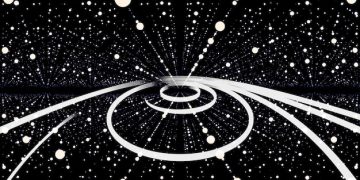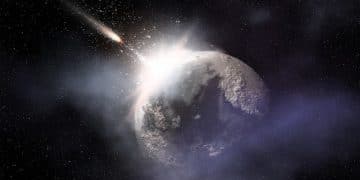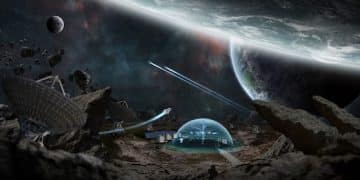Track the ISS from Your Backyard: A Practical Guide
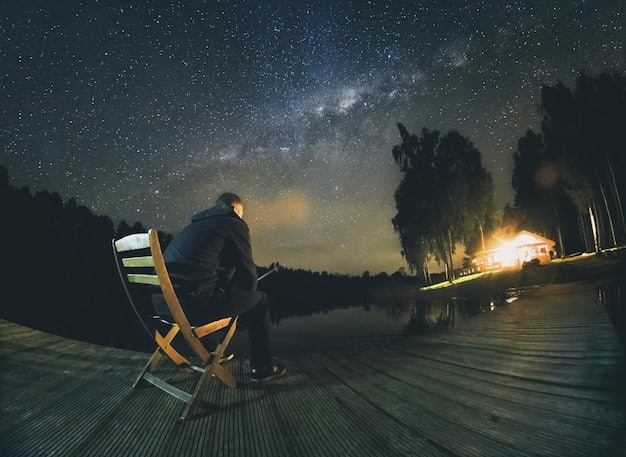
Tracking the International Space Station from your backyard is achievable using publicly available data, offering a unique opportunity to connect with human space exploration through accessible tools and methods.
Ever gazed at the night sky, wondering if you could spot something truly extraordinary, something created by human ingenuity soaring silently above? The vision of tracking the International Space Station (ISS) might seem like a dream reserved for professional astronomers, but with a few practical solutions: how to track the International Space Station (ISS) from your backyard using publicly available data, this cosmic pursuit is well within your grasp. Prepare to turn your backyard into a personal observatory, connecting with humanity’s greatest offshore outpost in space.
understanding the ISS and its orbital mechanics
Before embarking on your backyard ISS tracking adventure, it’s essential to grasp the basics of what the International Space Station is and how it moves through space. This understanding forms the bedrock of successful observation, allowing you to anticipate its appearances with accuracy.
The ISS is not merely a satellite; it’s a monumental achievement of international collaboration, a continuously inhabited scientific research laboratory orbiting Earth. It’s roughly the size of a football field, making it one of the brightest objects in the night sky, often mistaken for a very bright star or even a fast-moving plane.
what is the ISS?
The International Space Station, a joint project involving five participating space agencies, is the largest modular space station currently in low Earth orbit. It serves as a microgravity laboratory where scientific research is conducted in various fields, contributing to advancements in medicine, physical sciences, and technology. Hundreds of astronauts from multiple countries have visited, lived, and worked aboard the ISS since its first component was launched in 1998.
- Size and Visibility: At approximately 109 meters long, 73 meters wide, and 20 meters high, the ISS is incredibly vast. Its large solar arrays reflect sunlight, making it highly visible during specific times.
- Crew: Typically hosts a crew of six astronauts, rotating periodically.
- Purpose: A unique platform for scientific research, international collaboration, and demonstrating technologies for future space exploration.
orbital mechanics: how the ISS moves
The ISS orbits Earth at an average altitude of about 400 kilometers (250 miles). What makes tracking it fascinating is its speed and orbit. It zips around our planet at roughly 28,000 kilometers per hour (17,500 mph), completing one full orbit every 90 minutes. This incredible speed means it travels from horizon to horizon in just a few minutes during a visible pass.
Its orbit is inclined at 51.6 degrees to the equator, meaning it passes over roughly 90% of the Earth’s populated areas. This inclination is crucial because it dictates which latitudes get to see it. If you live within this band, you’re in luck! Its path shifts slightly with each orbit due to gravitational perturbations and atmospheric drag, necessitating accurate, real-time tracking data.
- Altitude: Roughly 400 km (250 miles) above Earth.
- Speed: Approximately 28,000 km/h (17,500 mph).
- Orbital Period: About 90 minutes per orbit.
- Inclination: 51.6 degrees, covering much of the world.
Understanding these fundamental aspects of the ISS and its orbital dance is the first step towards transforming abstract data into tangible observation. With this knowledge, you’re better prepared to interpret the tracking information and confidently locate it in the night sky.
accessing publicly available tracking data
The foundation of successful ISS tracking lies in accessing and interpreting real-time orbital data. Fortunately, a wealth of publicly available resources makes this incredibly easy. Far from being arcane astronomical charts, these tools are designed for public consumption, offering user-friendly interfaces that turn complex calculations into simple, actionable information.
The key to reliability is to use official or reputable sources. These sources often derive their data from NORAD (North American Aerospace Defense Command), which tracks thousands of objects in Earth orbit, including the ISS. This ensures that the predictions you receive are based on the most current and accurate orbital elements.
nasa and space agency websites
NASA’s dedicated tracking pages are arguably the most authoritative source. They provide comprehensive information, including real-time location maps, upcoming visible passes for your specific location, and even live feeds from the ISS itself. Their simplicity makes them ideal for beginners, yet their accuracy satisfies seasoned skywatchers.
- Nasa Spot the Station: This highly recommended tool allows you to input your location (city or coordinates) and receive email or text alerts for upcoming visible passes. It provides precise times, duration, maximum height, and appearance/disappearance directions.
- ESA (European Space Agency) and Roscosmos (Russian Space Agency): While less focused on public tracking tools for individual users, their websites often feature educational resources and real-time maps that can supplement your tracking efforts.
third-party websites and applications
Beyond official agency sites, a plethora of third-party websites and mobile apps leverage the same public data to offer even more tailored and feature-rich tracking experiences. These often provide enhanced visual representations, notifications, and integration with other astronomical data.
- Heaven-Above.com: A long-standing favorite among amateur astronomers, Heaven-Above offers detailed predictions for the ISS and thousands of other satellites. You can set your location, and it will generate a list of upcoming passes, complete with brightness estimates (magnitude), transit paths, and star charts to help you find it.
- ISS Tracker (online tool): Many simple, intuitive websites exist solely for tracking the ISS in real-time on a global map, often showing its current position, ground track, and illumination.
When using these resources, remember to always verify your location settings are accurate. Even a slight discrepancy can lead to incorrect pass predictions. Many apps use your device’s GPS, ensuring pinpoint accuracy, while websites require manual input or browser location services permission.
essential tools and preparation for observation
While tracking the ISS conceptually relies on data, successful observation in your backyard hinges on a few practical tools and a modicum of preparation. You don’t need expensive equipment; some of the best observations are made with the naked eye, demonstrating the ISS’s remarkable brightness.
Think of it as preparing for a mini astronomical event. Just as you’d check the weather before a picnic, you’ll need to assess the sky conditions. A clear sky is paramount, but even thin clouds can obscure your view of the station.
the naked eye and binoculars
The good news is that the ISS is typically bright enough to be seen with the unaided eye. On a clear night, especially during its brightest passes, it appears as a very bright, fast-moving “star” crossing the sky. Its constant, unwavering light distinguishes it from aircraft, which typically have blinking navigation lights.
For an enhanced view, a pair of binoculars is your best friend. Even standard 7×50 or 10×50 binoculars (7 or 10 magnification, 50mm objective lens diameter) will resolve the ISS into a distinct, elongated shape. You might even discern some of its major components, like the solar arrays, as it passes directly overhead. The key with binoculars is to practice tracking a moving object; it takes a steady hand and a quick eye.
- Naked Eye: Sufficient for most visible passes due to its size and reflective surfaces.
- Binoculars: Enhance details; practice tracking to keep it in view.
- Telescopes: Advanced users can use telescopes for highly detailed views, but they are challenging to track with due to the ISS’s speed.
dark skies and clear views
Light pollution is the bane of urban skygazers, but for the ISS, it’s less of an issue than it is for fainter deep-sky objects. Because the ISS is so bright, you can often see it even from brightly lit cities. However, a darker location will undoubtedly improve the contrast and make for a more spectacular viewing experience.
What truly matters is an unobstructed view of the sky, especially towards the horizon where the ISS will first appear and last disappear. Tall buildings, trees, or hills can block your line of sight. Choose a spot in your backyard or a nearby open field with a wide-open vista.
Checking the weather forecast for cloud cover is crucial. Even a thin layer of haze can dim or completely obscure the ISS. Clear, crisp nights are ideal. Also, consider the moon phase; a full moon can sometimes wash out fainter objects, but again, the ISS is usually bright enough to withstand this.
In summary, while high-tech equipment isn’t a prerequisite, having a good pair of binoculars, a clear understanding of its path, and an unobstructed view will significantly enhance your backyard ISS tracking experience. It’s about being prepared and knowing what to expect.
step-by-step guide to tracking the ISS
Now that you understand the ISS’s mechanics, know where to get data, and have your simple tools ready, it’s time for the practical steps of tracking it. This process is straightforward, but attention to detail will ensure a successful sighting.
Each pass of the ISS is a unique event, influenced by your location and the station’s orbital path. Therefore, real-time data is critical. Forget outdated star charts; rely on current predictions for accuracy.
step 1: identify upcoming passes for your location
Your first port of call is one of the tracking websites or apps mentioned earlier. Input your precise location (city, zip code, or even GPS coordinates for extreme accuracy). The tool will then generate a list of upcoming visible passes for your area.
Pay close attention to key information provided for each pass:
- Date and Time: Exactly when the ISS will appear and disappear. This is usually given in local time.
- Duration: How long the ISS will be visible in the sky. Longer durations usually mean higher and brighter passes.
- Maximum Height (Elevation): This is usually given in degrees, measured from the horizon (0 degrees) to directly overhead (90 degrees). Higher elevation passes are brighter and easier to see. A pass above 40 degrees is generally good; above 60 degrees is excellent.
- Appearance Direction: The compass direction (e.g., NW for northwest, SW for southwest) from which the ISS will first become visible.
- Disappearance Direction: The compass direction where the ISS will fade from view.
Choose a pass that has a high maximum height (e.g., over 45 degrees) and a reasonable duration (several minutes) for your first attempt. These will be the brightest and easiest to spot.
step 2: prepare your observation spot
Once you’ve selected a promising pass, head to your chosen observation spot. Ensure it has a clear view of the horizons in the appearance and disappearance directions. If you’re using binoculars, have them ready. If it’s cold, dress warmly; if it’s humid, be prepared for potential dew on lenses.
Give your eyes time to adapt to the dark, especially if you’re in a darker location. Turn off any unnecessary lights in your backyard that might hinder your night vision. Remember, the ISS will be illuminated by the sun, so ambient light from your house won’t affect its brightness, but it will impact your ability to discern fainter stars for directional reference.
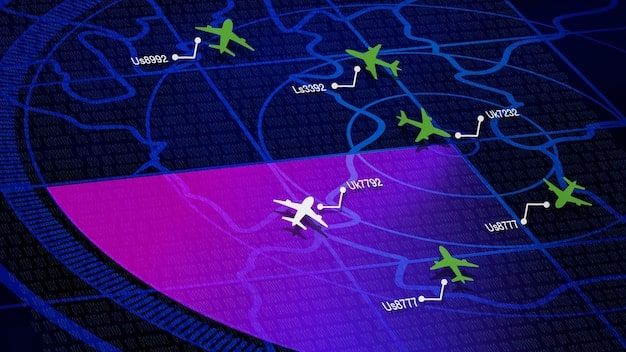
step 3: orient yourself and watch
A few minutes before the predicted appearance time, face the direction the ISS is expected to appear. Use cardinal directions (North, South, East, West) to orient yourself. Many phone apps have compass features, which can be useful here. You can also use prominent landmarks if you know their general direction from your vantage point.
As the predicted time approaches, scan the area where the ISS is supposed to appear. It generally looks like a slow-moving, intensely bright star. Unlike an airplane, it won’t have blinking lights and will maintain a steady, smooth trajectory. It will gradually brighten as it climbs higher in the sky, reaching its peak brightness and elevation at the “maximum height” point.
If using binoculars, don’t try to find it with them initially. Spot it with your naked eye first, then bring your binoculars up to your eyes and track it. Practice this sequence, as trying to find a fast-moving object through narrow binocular fields of view can be frustrating.
As it moves across the sky, follow its path. It will eventually begin to dim, especially if it passes into Earth’s shadow (typically indicated by its disappearance time). This fading is a fascinating part of the experience, as it literally flies out of the sun’s light.
By following these steps, you’ll transform complex orbital mechanics into a rewarding, real-world sighting. The feeling of seeing the ISS, knowing humans are living and working aboard that speck of light, is truly inspiring.
troubleshooting and tips for successful sightings
Even with precise data and careful preparation, your first few attempts at spotting the ISS might not be perfect. That’s entirely normal. Patience and a few troubleshooting tips will significantly improve your chances and make it a consistently rewarding experience.
The dynamic nature of the ISS’s orbit and variable atmospheric conditions can pose challenges. Knowing how to adapt to these variables is a hallmark of an experienced skywatcher.
common challenges and solutions
- Cloud Cover: The most common spoiler. Even thin, high clouds can obscure the ISS.
- Solution: Always check the weather forecast. Many tracking apps integrate real-time cloud map layers. If clouds are predicted, reschedule your viewing.
- Light Pollution: While the ISS is bright, severe light pollution can still make it harder to pick out against a busy sky.
- Solution: Find the darkest spot possible in your backyard or surroundings. If you must observe from a brightly lit area, focus on passes with very high peak elevations (e.g., 70-90 degrees) where it will be at its brightest.
- Incorrect Orientation: Misjudging directions can lead to missing the appearance or looking in the wrong part of the sky.
- Solution: Use a compass or a compass app on your phone to orient yourself accurately to north, south, east, and west before the pass begins. Familiarize yourself with landmark directions from your observation spot.
- Missing the Beginning: The ISS appears suddenly and can be surprisingly faint at first.
- Solution: Start looking a few minutes before the predicted appearance time, meticulously scanning the predicted appearance direction. Be patient; it will emerge from the twilight.
advanced tips for enhanced viewing
Once you’ve mastered basic naked-eye observations, you can enhance your experience with these tips:
- Magnitude and Brightness: Pay attention to the “magnitude” reported by tracking sites (e.g., -3.5, -4.0). The lower the number (even negative), the brighter the object. The ISS can be as bright as Venus (around magnitude -4), making it incredibly conspicuous. Prioritize passes with high negative magnitudes for breathtaking views.
- Transit Predictions: Some advanced tracking sites can predict “transits” – moments when the ISS passes directly in front of the sun or moon, or even a planet. These are highly challenging to observe and require specialized equipment and precise timing but offer incredible photographic opportunities if you’re an astrophotographer. This is not for a beginner, but it’s an exciting advanced goal.
- App Integration: Many mobile astronomy apps (like SkyView Lite, Star Walk 2, or Stellarium Mobile) include ISS tracking. They use your phone’s gyroscope and GPS to show you exactly where to point your device to find the ISS, often with augmented reality (AR) features. This can be incredibly helpful for beginners.
Remember, every observation is a learning experience. Don’t be discouraged by initial misses. Each attempt refines your skills and deepens your appreciation for the science and technology that makes these sightings possible.
understanding the data: TLEs and Satellite Tracking Software
For those who want to delve deeper than simply using online tools, understanding Two-Line Element sets (TLEs) and how satellite tracking software utilizes them provides a profound insight into the mechanics of orbital prediction. This moves beyond merely consuming data to understanding its raw form.
While not strictly necessary for casual observation, comprehending TLEs empowers you with a more robust understanding of how all satellite tracking applications function. It’s the language of orbital mechanics simplified into a digestible format for computers.
what are TLEs?
Two-Line Element sets are a standard data format used to encode orbital state vectors of Earth-orbiting objects at a specific time. Each TLE consists of two lines, plus a preceding satellite name line, containing a plethora of parameters that define an object’s orbit:
ISS (ZARYA) 1 25544U 98067A 24001.00000000 .00000000 00000-0 00000+0 0 9997 2 25544 51.6433 133.0768 0005700 242.0673 117.9327 15.49887752408993
This might look like gibberish, but each number represents a crucial orbital parameter, such as inclination, right ascension of the ascending node, eccentricity, argument of perigee, mean anomaly, and mean motion. These numbers, combined with the epoch (the time at which the TLE is valid), allow specialized software to propagate the satellite’s future position with high accuracy.
- Data Format: Standardized numerical representation of an object’s orbit.
- Parameters: Includes inclination, eccentricity, mean motion, and epoch.
- Source: Regularly updated by NORAD and accessible via various space data repositories.
using satellite tracking software with TLEs
Instead of relying on websites that do the calculation for you, you can download a TLE file (often updated daily or several times a day) and feed it into a dedicated satellite tracking program. These programs then use complex algorithms (like SGP4/SDP4) to predict the satellite’s future positions based on these TLEs.
Examples of such software include:
- Orbitron: A free, powerful satellite tracking program for Windows that can import TLEs and display real-time positions, ground tracks, and future pass predictions.
- Gpredict: A real-time satellite tracking and orbit prediction application for Linux, macOS, and Windows. It supports various satellites and allows for extensive customization.
- Heavens-Above application (desktop versions): While a website, some users prefer its raw TLE output for use with their own software.
The advantage of using dedicated software and TLEs is the control and depth of information you gain. You can customize views, predict passes days or weeks in advance, and, in some cases, even integrate it with robotic telescopes. While requiring a bit more technical proficiency, it provides a comprehensive and highly flexible approach to satellite tracking, allowing you to appreciate the underlying computational power behind every simple “Spot the Station” alert.
impact and significance of tracking the ISS
Beyond the simple joy of spotting a human-made object in orbit, tracking the International Space Station from your backyard carries a deeper significance. It serves as a tangible link to our species’ endeavors beyond Earth, inspiring awe, fostering scientific curiosity, and underscoring the collaborative spirit of space exploration.
Every time you glance up and catch that luminous speck traversing the night sky, you’re not just observing a satellite; you’re witnessing history and progress, a testament to human ingenuity and international cooperation.
fostering curiosity and education
For children and adults alike, seeing the ISS pass overhead is often a profound experience that ignites curiosity about space, science, and engineering. It makes the abstract concept of space exploration incredibly real and immediate. It can lead to questions about:
- Orbital Mechanics: How does it stay up there? Why doesn’t it fall to Earth?
- Life in Space: What’s it like to live on the ISS? What do astronauts do?
- Scientific Research: What kind of experiments are conducted on board? How do they benefit us on Earth?
These questions can be gateways to learning more about STEM fields, encouraging the next generation of scientists, engineers, and explorers. Educators often use ISS tracking as a simple yet powerful classroom activity, connecting students directly to live space missions.
a symbol of international collaboration
The ISS is not just an American or Russian project; it’s a global endeavor involving 15 nations working together to push the boundaries of human knowledge. Tracking it serves as a powerful reminder of what humanity can achieve when it unites for a common purpose, transcending geopolitical differences.
Its regular appearance in our skies, visible from almost anywhere, symbolizes a shared human journey. It represents peace, scientific progress, and the boundless potential of international partnership, continuously orbiting above all nations, regardless of terrestrial conflicts.

connection to the future of space exploration
The ISS is not merely a destination; it’s a stepping stone. The research conducted on board—on human physiology in microgravity, advanced materials, and environmental control—is crucial for future long-duration missions to the Moon, Mars, and beyond. Every pass of the ISS is a continuous reminder that humanity’s reach extends far beyond our home planet.
Tracking the ISS, therefore, isn’t just a hobby; it’s a participation, however small, in the unfolding story of human space exploration. It’s a personal connection to the astronauts currently living and working off-world, performing vital research that will pave the way for humanity’s future in the cosmos. It bridges the gap between scientific ambition and everyday life, making the extraordinary accessible to everyone.
leveraging communities and citizen science
The joy of tracking the ISS can be amplified by connecting with a global community of enthusiasts and even contributing to citizen science initiatives. You are not alone in your fascination; millions around the world share this interest, creating vibrant communities both online and offline.
These communities offer support, share tips, and provide additional valuable insights, transforming a solitary observation into a shared experience. They are also platforms for continuous learning and engagement.
online forums and social media groups
A quick search on platforms like Facebook, Reddit (e.g., r/ISS, r/astronomy), and dedicated astronomy forums will reveal numerous groups focused on ISS tracking and general skywatching. These are excellent places to:
- Share Your Sightings: Post photos, describe your experiences, and connect with others who witnessed the same pass.
- Ask Questions: Get advice on troubleshooting, equipment, or specific pass predictions.
- Learn from Experts: Many seasoned skywatchers and amateur astronomers share their knowledge and tips, often helping newcomers improve their observation skills.
These online spaces are dynamic and provide real-time updates and discussions, enriching your tracking experience.
local astronomy clubs and events
Many cities and regions have local amateur astronomy clubs. These clubs often host public star parties and observation nights. Attending these events can be incredibly beneficial:
- Structured Viewing: Some clubs regularly organize ISS viewing events, taking the guesswork out of locating it.
- Expert Guidance: You can get hands-on advice from experienced astronomers on everything from using binoculars to identifying constellations.
- Access to Equipment: Clubs often have telescopes that members can use, allowing you to see the ISS with much greater detail than with simple binoculars (though tracking it through a telescope is an advanced skill).
These in-person interactions foster camaraderie and make learning even more engaging.
citizen science contributions
While direct citizen science projects involving ISS tracking are less common than, say, exoplanet hunting, your observations can still contribute indirectly:
- Reporting Anomalies: If you observe something unusual during an ISS pass (e.g., unexpected brightness changes, unusual trajectory), you can report it to relevant forums or even space agencies. While rare, such observations can sometimes provide useful data.
- Educational Outreach: By sharing your passion and knowledge with friends, family, and local communities, you become an ambassador for space exploration. Your firsthand accounts can inspire others to look up and engage with science.
In essence, tracking the ISS is not just a personal activity but an opportunity to become part of a larger community that celebrates human achievement in space. Sharing your experiences and learning from others makes the journey even more rewarding and impactful.
| Key Point | Brief Description |
|---|---|
| 🛰️ Data Sources | Utilize official NASA/ESA tools or reputable third-party apps for accurate pass predictions based on TLEs. |
| 🔭 Tools Needed | Naked eye is sufficient, binoculars enhance views, no specialized equipment required for basic tracking. |
| ⏱️ Preparation | Check weather, find an unobstructed view, and orient yourself using compass directions before viewing. |
| ✨ Significance | Inspires curiosity, fosters education, symbolizes international collaboration, and links to future space exploration. |
Frequently Asked Questions about Tracking the ISS
▼
The ISS is incredibly bright, often appearing brighter than most stars and planets, sometimes even rivaling Venus. Its apparent magnitude can range from about -2.0 to -4.0, with lower numbers indicating greater brightness. This makes it easily visible to the naked eye under clear skies, even from urban areas with significant light pollution.
▼
The ISS does not have its own lights for illumination at night. Its visibility depends entirely on reflecting sunlight. When it appears or disappears abruptly, it means it’s entering or exiting Earth’s shadow. As it crosses the terminator (the line separating day from night on Earth), it either catches the first rays of sunlight or becomes engulfed in darkness, causing it to suddenly brighten or fade.
▼
While possible, seeing specific details like individual modules or solar panels through backyard telescopes is extremely challenging. The ISS moves incredibly fast, making it difficult to keep in the field of view, especially at higher magnifications. Specialized tracking mounts are often required for detailed views or astrophotography. However, with good binoculars or a small telescope, you can often discern its general shape and the extent of its solar arrays.
▼
The ISS is most visible during the hours immediately after sunset and before sunrise. During these “twilight” periods, your location on Earth is dark, but the ISS, at its higher altitude, is still illuminated by the sun. Passes that are high in the sky (closer to 90 degrees elevation) and last longer (several minutes) are typically the best and brightest. These ideal passes occur in cycles throughout the year.
▼
Yes, tracking the International Space Station with your naked eye or through binoculars is completely safe. The ISS reflects sunlight, but it is not sending out harmful radiation or light. There’s no risk involved in observing it, unlike looking directly at the sun during a solar eclipse. Enjoy the view without any concerns about eye safety.
Conclusion
Tracking the International Space Station from your backyard is a surprisingly accessible and profoundly rewarding experience. It’s a testament to how publicly available data, combined with simple tools and a curious spirit, can connect us directly to the grand narrative of human space exploration. From understanding its orbital dance to utilizing advanced tracking tools, each step deepens your appreciation for this global endeavor. So, tonight, instead of just gazing idly at the stars, try to spot the ISS. It’s more than just a moving light; it’s a symbol of human ingenuity, collaboration, and our enduring quest to understand and explore the cosmos, passing silently overhead, waiting to be noticed.
